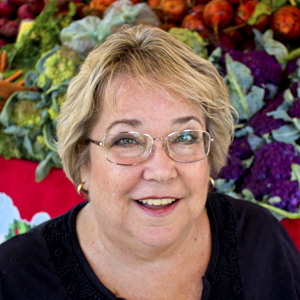By Deb Morris, PCFMA.org

You probably hated eating brassicas as a kid, burying them under your mashed potatoes or surreptitiously feeding them to the family dog. We’re sure you’ve changed your mind since then because brassicas are flavorful, easy-to-prepare, and nutrient-dense. The Brassica family of vegetables includes broccoli, cauliflower, cabbage, Brussels sprouts, bok choy, and more. They are among the most commonly cultivated vegetables in the world, and some of the most delicious.
Their flavor is incomparable when just-picked from your garden or grown (and not shipped from long distances) from local farmers. The fresher the vegetables are, the more nutrients they contain.
We know vegetables are good for you and we need more in our diet, but brassicas give you a lot of bang for your buck. Relatively inexpensive, they are low in calories, fat, and sodium. They’re also a very good source of fiber and are filled with a variety of other essential vitamins and minerals.
The broccoli, cabbage, cauliflower, Brussels sprouts, and other brassicas from small family farms in Watsonville, Gilroy, and Merced are gorgeous right now.
Here are five brassicas to include in your diet with the best ways to prepare them for best flavor and nutrient retention:
Broccoli & Broccolini: Blanched, steamed, or sautéed, broccoli can be added to pasta, casseroles, or stir-fries. Make a baked broccoli gratin with some California cheese. Or stir fry with mush- rooms in a hoisin-based sauce.
Cauliflower: Currently cauliflower is having its culinary moment as low-carb meals are in vogue. Chefs and home cooks are discovering creative ways to prepare it – riced, roasted, mashed. Roasting brings out the mild, nutty flavor.
Brussels Sprouts: Roasted, steamed, or grilled, they make a perfect accompaniment to most meals. Try cutting in half, toss with olive oil, salt and pepper, and roasting in the oven – delicious! Saute with bacon or shred into salads and slaws.
Cabbage: Whatever variety – red or purple cabbage, Napa cabbage, Savoy cabbage, green cabbage, use in cole slaw and other salads, add to soups, top your fish tacos, or make old-fashioned cabbage rolls.
Bok Choy: Also known as Chinese cabbage, bok choy is a staple in Asian cooking and is most commonly used in soups, stir-fries, or noodle dishes. Add to your pasta dishes or light soups.
Purple Cauliflower Rice
•1 large head cauliflower, quartered
•3 tablespoons olive oil, butter or bacon drippings
•1 medium onion, leek or 2 shallots
•2 tablespoons fresh
•Fresh parsley
•Juice of 1/4 to 1/2 lemon, to taste
•Salt and pepper, to taste
Trim the cauliflower by quartering it, laying a flat side on your cutting board and making a diagonal cut to separate the florets from the core. In 4 batches, break up the florets into a food processor and pulse until the mixture resembles pebbles.
Heat oil in a large skillet over medium-high heat. Add the oil and heat; add onions, shallots, or leeks, and stir to coat. Continue cooking, stirring frequently, until the onions are golden brown at the edges and have softened for about 8 minutes. If using leeks, cook 5 minutes. If using shallots, cook 2 minutes. Add cauliflower and stir to combine. Add 1 teaspoon salt, and continue to cook, stirring frequently, until the cauliflower has softened, 3 to 5 minutes. Remove from the heat.
Spoon the cauliflower into a large serving bowl, garnish with parsley, sprinkle with the lemon juice, and season to taste with salt. Serve warm.

